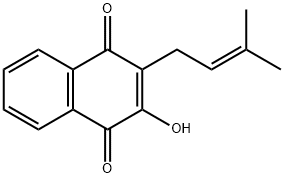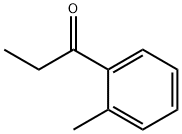LAPACHOL
Synonym(s):2-Hydroxy-3-(3-methyl-2-butenyl)-1,4-naphthoquinone;Natural Yellow 16
- CAS NO.:84-79-7
- Empirical Formula: C15H14O3
- Molecular Weight: 242.27
- MDL number: MFCD00001679
- EINECS: 201-563-7
- SAFETY DATA SHEET (SDS)
- Update Date: 2025-12-26 16:58:18

What is LAPACHOL?
Description
Lapachol, a benzoquinone, is a secondary allergen in teak (Tectona grandis).
Occurrence
Lapacol (CI Natural Yellow 16; CI 75490) (lapachic acid, taiguie acid, tecomin) is a yellow pigment occurring in the wood of trees of the genus Tecoma, native to the West Indies and tropical South America. The shavings of the wood, treated with lime water, give an extract that dyes cotton yellow.
The Uses of LAPACHOL
It was used in the synthesis of the lapachol metal complexes.
The Uses of LAPACHOL
antineoplastic, antifungal
The Uses of LAPACHOL
Lapachol was used in the synthesis of the lapachol metal complexes.
What are the applications of Application
Lapachol is a natural naphthoquinone compound
Definition
ChEBI: Lapachol is a hydroxy-1,4-naphthoquinone that is 1,4-naphthoquinone substituted by hydroxy and 3-methylbut-2-en-1-yl groups at positions 2 and 3, respectively. It is a natural compound that exhibits antibacterial and anticancer properties, first isolated in 1882 from the bark of Tabebuia avellanedae. It has a role as a plant metabolite, an antineoplastic agent, an antibacterial agent and an anti-inflammatory agent. It is a hydroxy-1,4-naphthoquinone and an olefinic compound.
General Description
Lapachol is natural naphthoquinone compound derived from Bignoniaceae (Tabebuia sp.).
Contact allergens
Lapachol, a benzoquinone, is a secondary allergen in teak (Tectona grandis L., Verbenaceae family), a wood largely used for various indoor and outdoor applications (doors, windows, etc.) because of its strong durability. It has similar reactivity to deoxylapachol. Seealso Chap. 46
Biochem/physiol Actions
Lapachol has antimicrobial properties against many pathogens. It has anti-inflammatory, analgesic and antibiotic properties. It is inhibitor of epithelial tumors in Drosophila melanogaster heterozygote.
Purification Methods
Crystallise Lapachol from pet ether/EtOH, EtOH or Et2O. [Beilstein 8 H 326, 8 I 644, 8 II 365, 8 III 2720.]
Properties of LAPACHOL
| Melting point: | 141-143 °C(lit.) |
| Boiling point: | 325.09°C (rough estimate) |
| Density | 1.2077 (rough estimate) |
| refractive index | 1.5740 (estimate) |
| storage temp. | Sealed in dry,Room Temperature |
| solubility | ethanol: soluble10mg/mL, clear, light yellow to yellow |
| form | Solid |
| Colour Index | 75490 |
| pka | 4.81±0.10(Predicted) |
| color | Yellow to Dark Yellow |
| Merck | 13,5382 |
| CAS DataBase Reference | 84-79-7 |
Safety information for LAPACHOL
| Signal word | Warning |
| Pictogram(s) |
 Exclamation Mark Irritant GHS07 |
| GHS Hazard Statements |
H302:Acute toxicity,oral |
Computed Descriptors for LAPACHOL
| InChIKey | CIEYTVIYYGTCCI-UHFFFAOYSA-N |
New Products
4,4-Difluoropiperidine hydrochloride tert-butyl 9-methoxy-3-azaspiro[5.5]undecane-3-carboxylate Indole Methyl Resin N-Isopropylurea N,N-Dicyclohexylcarbodiimide(DCC) MELDRUMS ACID 5-METHYLISOXAZOLE-4-CARBOXYLIC ACID Magnessium Bis glycinate Zinc ascorbate 1-bromo-2-butyne 2-acetamidophenol 9(10H)-anthracenone Erythrosin B, 4-Piperidinopiperidine 2-((4-morpholinophenylamino) (methylthio) methylene) malononitrile 2,4-dihydroxybenzaldehyde 3-(4-morpholinophenylamino)-5-amino-1H-pyrazole-4-carbonitrile Methyl 2-methylquinoline-6-carboxylate 2,6-dichloro-4-nitropyridine 4-Bromo-2-chlorobenzonitrile 2-(benzylamino)acetic acid hydrochloride 4-(tert-Butoxycarbonylamino)but- 2-ynoic acid 3,4-dihydro-2H-benzo[b][1,4]dioxepine 1-Phenyl-1-cycloprppanecarboxylicacidRelated products of tetrahydrofuran








You may like
-
 Lapachol CAS 84-79-7View Details
Lapachol CAS 84-79-7View Details
84-79-7 -
 Lapachol CAS 84-79-7View Details
Lapachol CAS 84-79-7View Details
84-79-7 -
 3-(4-amino-1-oxoisoindolin-2-yl)-1-methylpiperidine-2,6-dione 98%View Details
3-(4-amino-1-oxoisoindolin-2-yl)-1-methylpiperidine-2,6-dione 98%View Details -
 614-19-7 98%View Details
614-19-7 98%View Details
614-19-7 -
 20677-73-0 (2,2-diethoxyethyl)methylamine 98%View Details
20677-73-0 (2,2-diethoxyethyl)methylamine 98%View Details
20677-73-0 -
 3-(4-(hydroxyamino)-1-oxoisoindolin-2-yl)piperidine-2,6-dione 98%View Details
3-(4-(hydroxyamino)-1-oxoisoindolin-2-yl)piperidine-2,6-dione 98%View Details -
 57381-49-4 2-bromo-4-chlorobenzonitrile 98%View Details
57381-49-4 2-bromo-4-chlorobenzonitrile 98%View Details
57381-49-4 -
 4,6-dichloropyrimidine-5-carbaldehyde 98%View Details
4,6-dichloropyrimidine-5-carbaldehyde 98%View Details
5305-40-8
